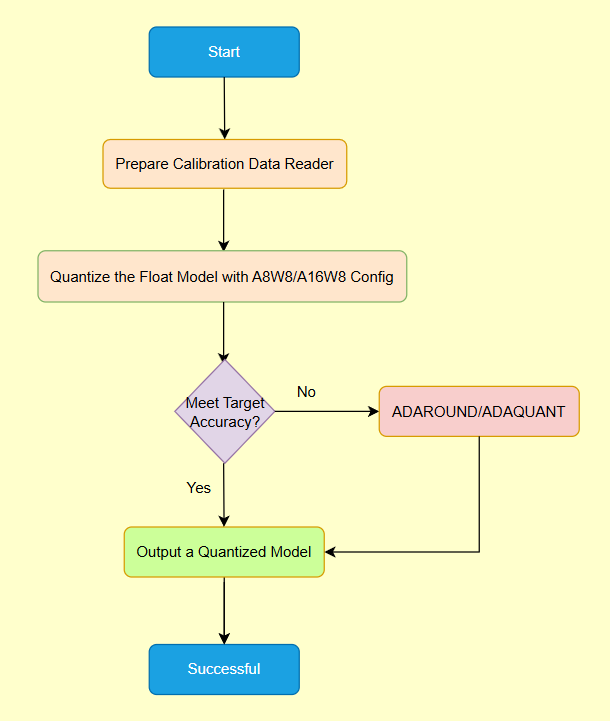Float Scales (A8W8 and A16W8) Quantization#
Note
In this documentation, AMD Quark is sometimes referred to simply as “Quark” for ease of reference. When you encounter the term “Quark” without the “AMD” prefix, it specifically refers to the AMD Quark quantizer unless otherwise stated. Please do not confuse it with other products or technologies that share the name “Quark”.
Introduction#
A8W8 and A16W8 are two commonly used quantization configurations for the Ryzen AI NPU.
A8W8: Uses symmetric INT8 activation, symmetric INT8 weight, and symmetric INT32 bias quantization with float scales.
A16W8: Uses symmetric INT16 activation, symmetric INT8 weight, and symmetric INT32 bias quantization with float scales.
As the activation bit width increases, the quantized model’s accuracy improves. This means A16W8 generally offers better accuracy than A8W8. However, A8W8 provides better performance compared to A16W8.
Please choose the appropriate quantization configuration based on your specific needs. This guide explains how to quantize a float model using the A8W8 or A16W8 configuration and provides strategies to improve accuracy.
How to Quantize a Float Model with A8W8/A16W8 Config#

Figure 1. How to Quantize a Float Model with A8W8/A16W8 Config#
As the Figure 1 shows, you can refer to codes below:
from quark.onnx.quantization import QConfig
from quark.onnx import ModelQuantizer
# Define model paths
# Path to the float model to be quantized
float_model_path = "path/to/float_model.onnx"
# Path where the quantized model will be saved
quantized_model_path = "path/to/quantized_model.onnx"
calib_data_folder = "path/to/calibration_data"
model_input_name = 'model_input_name'
# Define calibration data reader for static quantization
class CalibDataReader(CalibrationDataReader):
def __init__(self, calib_data_folder: str, model_input_name: str):
self.input_name = model_input_name
self.data = self._load_calibration_data(calib_data_folder)
self.data_iter = None
# Customize this function to preprocess calibration datasets as needed
def _load_calibration_data(self, data_folder: str):
# Example: Implement the actual data preprocessing here
processed_data = []
"""
Define preprocessing steps for your dataset.
For instance, read images and apply necessary transformations.
"""
return processed_data
def get_next(self):
if self.data_iter is None:
self.data_iter = iter([{self.input_name: data} for data in self.data])
return next(self.data_iter, None)
# Instantiate the calibration data reader
calib_data_reader = CalibDataReader(calib_data_folder, model_input_name)
# Set up quantization with a specified configuration
# For example, use "A8W8" for Ryzen AI A8W8 quantization
quantization_config = QConfig.get_default_config("A8W8")
quantizer = ModelQuantizer(quantization_config)
# Quantize the ONNX model and save to specified path
quantizer.quantize_model(float_model_path, quantized_model_path, calib_data_reader)
Note
In the quantization, graph optimization will be automatically performed.
How to Measure Accuracy (Compare Differences between FP32 and A8W8/A16W8)#
infer float32 and a8w8/a16w8 quantized models and save results
You can refer to the following code to infer the float32 and A8W8/A16W8 quantized models and save the results.
import numpy as np
import os
import onnxruntime as ort
def infer_model_and_save_output(onnx_model_path, input_data_loader, output_dir):
ort_session = ort.InferenceSession(onnx_model_path)
# Assume the model has only one input.
input_name = ort_session.get_inputs()[0].name
for index, input_data in enumerate(input_data_loader):
ort_inputs = {input_name: input_data}
ort_outs = ort_session.run(None, ort_inputs)
output_numpy = ort_outs[0]
os.makedirs(output_dir, exist_ok=True)
output_file = os.path.join(output_dir, str(index) + ".npy")
np.save(output_file, output_numpy)
print(f"Results saved to {output_dir}.")
onnx_model_path = "float32_model.onnx" # Replace with "a8w8_quantized_model.onnx" or "a16w8_quantized_model.onnx"
# input_data_loader is an iterable object that returns a numpy tensor each time. It is user-defined.
output_dir = "baseline_results" # Replace with "quantized_results"
infer_model_and_save_output(onnx_model_path, input_data_loader, output_dir)
calculate differences
If you need to compare the differences between float32 and A8W8/A16W8 quantized models after conversion. We support some metrics (cosine similarity, L2 loss, PSNR) for comparing differences between float32 and A8W8/A16W8 quantized inference results. The formats (JPG, PNG and NPY) of inference result in folders are supported. you can use this command to compare:
python -m quark.onnx.tools.evaluate.py --baseline_results_folder $BASELINE_RESULTS_FOLDER_PATH --quantized_results_folder $QUANTIZED_RESULTS_FOLDER_PATH
How to Improve Quantization Accuracy#
If the accuracy of A8W8/A16W8 quantized model can not meet your target, you can improve quantization accuracy with adaround and adaquant finetuning. Here is examples of how to improve quantization accuracy with finetuning. For more detailed information, see Quantization Using AdaQuant and AdaRound.
ADAROUND
from quark.onnx.quantization.config.spec import QLayerConfig, Int8Spec, CalibMethod
from quark.onnx.quantization.config.algorithm import CLEConfig, AdaRoundConfig, AdaQuantConfig
activation_spec = Int8Spec(calibration_method=CalibMethod.MinMax) # Replace with Int16Spec when using A16W8
weight_spec = Int8Spec(calibration_method=CalibMethod.MinMax)
algo_conf = [CLEConfig(), AdaRoundConfig(num_iterations=1000, learning_rate=0.1)]
extra_info = {
'ActivationSymmetric': True,
'AlignSlice': False,
'FoldRelu': True,
'AlignConcat': True,
'AlignEltwiseQuantType': True,
}
config = QConfig(QLayerConfig(activation=activation_spec, weight=weight_spec), algo_config=algo_conf, **extra_info)
quantizer = ModelQuantizer(config)
quantizer.quantize_model(input_model_path, output_model_path, data_reader)
ADAQUANT
from quark.onnx.quantization.config.spec import QLayerConfig, Int8Spec, CalibMethod
from quark.onnx.quantization.config.algorithm import CLEConfig, AdaRoundConfig, AdaQuantConfig
activation_spec = Int8Spec(calibration_method=CalibMethod.MinMax) # Replace with Int16Spec when using A16W8
weight_spec = Int8Spec(calibration_method=CalibMethod.MinMax)
algo_conf = [CLEConfig(), AdaQuantConfig(num_iterations=1000, learning_rate=1e-6)]
extra_info = {
'ActivationSymmetric': True,
'AlignSlice': False,
'FoldRelu': True,
'AlignConcat': True,
'AlignEltwiseQuantType': True,
}
config = QConfig(QLayerConfig(activation=activation_spec, weight=weight_spec), algo_config=algo_conf, **extra_info)
quantizer = ModelQuantizer(config)
quantizer.quantize_model(input_model_path, output_model_path, data_reader)